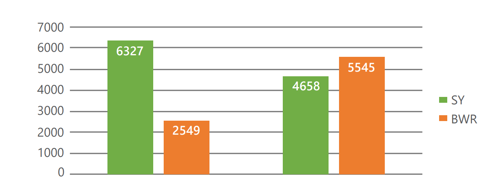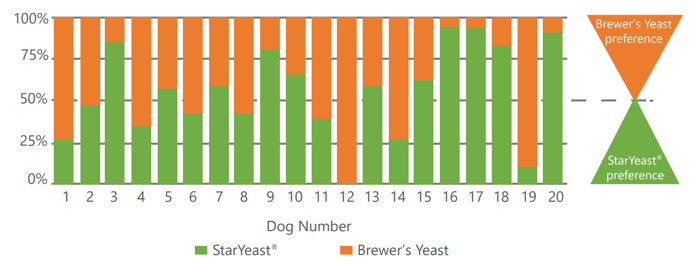Yeasts are traditionally widely used in dog and cat food because they are vegetable sources of high protein value, have an excellent balance of amino acids, and high levels of B-complex vitamins. They are also characterized by a high concentration of glutamic acid, giving them high palatability, making the feed more attractive, and increasing the animal intake.
StarYeast® is a 100% natural ingredient from Saccharomyces cerevisiae yeast fermentation using sugarcane juice as substrate.
This material presents the result of a test held at Kennelwood where the goal was to compare the palatability of StarYeast® inactive molasses yeast as an alternative to brewer’s yeast, traditionally used in pet food.
Experimental Data
- Animals – 20 Beagle dogs (male and female)
- Trial period - 2 days
- Treatments - 1. Basal diet + 1% Star Yeast, 2. Basal diet + 1% Brewer’s yeast
800 g of each ration were offered in a panel of 20 dogs
The positions of the feeders were reversed daily to prevent “left-right” trends
The products application were “on top” over extruded feed - Statistics - Student T-test
Composition of basal diet
Ground corn, poultry by-product flour, wheat flour, oats, beet pulp, white rice, pork and bone meal, flaxseed, brewer’s dried yeast, potassium chloride, vitamins [choline chloride, vitamin E, ascorbic acid, calcium carbonate, riboflavin supplement, niacin supplement, calcium pantothenate, vitamin A supplement, vitamin D3 supplement, pyridoxine hydrochloride, d-biotin, vitamin B12 supplement, thiamine mononitrate, folic acid], salt, dry whey, minerals [zinc sulfate, manganese sulfate, ferrous sulfate, magnesium sulfate, zinc protein, ferrous protein, manganese protein, copper sulfate, magnesium protein, copper protein, calcium iodate], Sodium Selenite, Choline Chloride, Antioxidant.
Results
GRAPH 1: TOTAL CONSUMPTION OF THE 20 DOGS ON DAY 1 AND DAY 2.
StarYeast® was widely preferred on both days. The repartition of consumption
was closer. On all experiments, StarYeast® was the preference at a ratio of 1,36 to
1, based on the total consumption. Although, according to the student t-test, no
significant difference has been observed between the two diets.

Student’s t-test: paired with two samples for obtaining the average. The calculated value of “t” is 1.07.
5% significance level
The table distribution value of “t” is 2.09. Therefore no preference exists at a 5% level of significance.
GRAPH 2: PREFERENCE OF EACH DOG AND DISTRIBUTION OF DIET CONSUMPTION FOR EACH DOG.
Example: Dog N°1 consumes around 25% of the diet with StarYeast and 75% with brewer yeast. The result shows that 11 dogs on 20 preferred StarYeast®.

Read the original article here.

